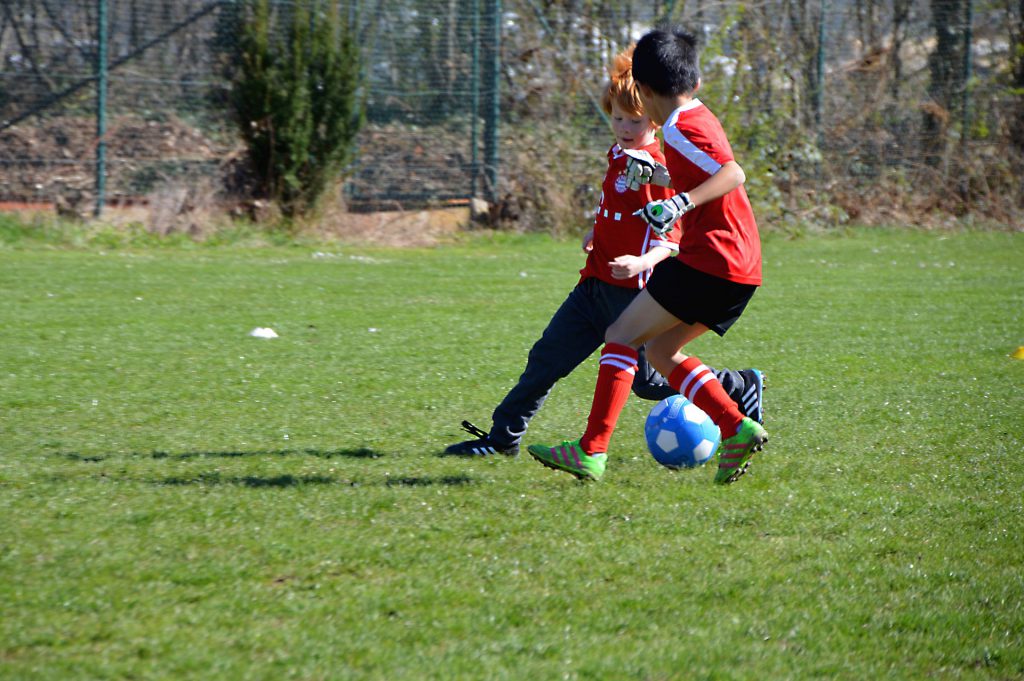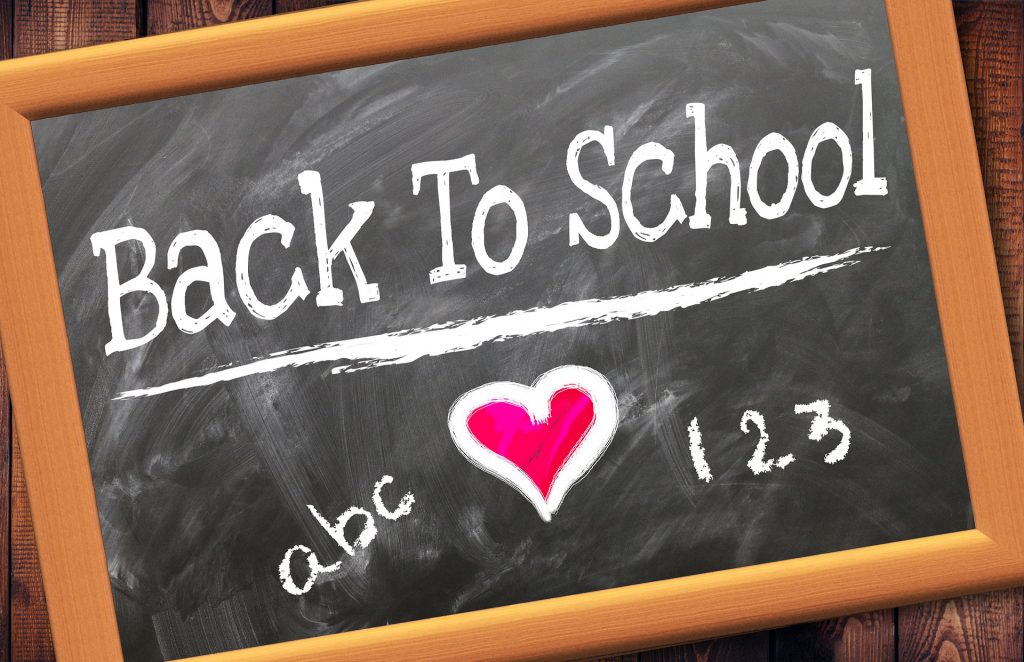Soccer

Did you know September is National Youth Soccer Month? Children of all ages can practice basic soccer skills, and school-aged children can join a local team. They may even enjoy playing a casual game with their friends and neighbors!
Here are a few soccer fundamentals your children can practice. Children that are too young to play organized soccer can try the first four techniques and get into organized games when they are old enough.
- Dribbling: moving the ball with your feet around the field
- Receiving: getting the ball from another player after they pass it to you
- Passing: kicking the ball to another player
- Shooting: getting the ball into the goal
- Heading: using your head to control the ball
- Tackling: using your foot to get the ball away from the player in possession of it, usually involving some contact with that player
To learn more about these fundamentals, visit http://ww2.nscaa.com/education/resources/fundamentals/dribbling.
Soccer is a great sport to improve heart health and prevent heart disease. Also, playing soccer can improve muscle and bone strength and reduce fracture risk. It’s a fun way to relieve stress and help keep blood pressure low!¹ Children can improve their balance and gross motor skills by practicing soccer fundamentals.
If your children don’t play soccer on a team, they can still play casually! You may be able to find a field at a park or at an open-access school or faith-based community (make sure to call and see if your children can use their facilities). You can also try the Soccer Field Finder app or this website to find soccer fields near you!
Where can your children play soccer this week?
References
- https://www.sciencedaily.com/releases/2010/04/100406093524.htm
Baseball and Softball

Did you know September is Little League Month? Little League is an organization for youth baseball and softball. Baseball and softball are great sports for children of all ages to try, even if they’re not on an organized team. Younger children can learn basic physical skills such as running, catching, and throwing. Whether you simply play catch with your children or they join a team, baseball and softball are fun ways for your children to get 60 minutes of daily physical activity!
Sports like baseball and softball foster values of teamwork and sportsmanship in children and adolescents. Baseball and softball incorporate all kinds of physical activity–running the bases gets your heart rate up, while swinging the bat, throwing, and catching can improve both strength and flexibility. Also, it can help improve hand-eye coordination, which is especially helpful for younger children still developing their motor skills.
While toddlers and preschoolers may not be able to play an organized baseball or softball game, you can still have them practice running to different bases and throwing and catching a ball from a short distance. Also, tee ball is a great way to ease into baseball and softball. Tee ball is a modified age-appropriate baseball game for children around 4-7 years old. Rather than batting the ball in the air, children bat the ball off of a tee.
Check out this link to find baseball and tee ball teams near you and this link to find softball team near you. Also, you can visit this link to determine which baseball or softball league is best for your child.
What baseball or softball league will your child join?
National Childhood Obesity Awareness Month

September is National Childhood Obesity Awareness Month. While some weight gain as children get older is natural and expected as they grow, gaining too much weight can cause problems. Overweight and obese children are at greater risk for health problems as they grow older. Many factors can contribute to a child’s risk of becoming obese, including how physically active they are. Physical activity behaviors are shaped by our environment, which provides a great opportunity for families to help each other maintain a healthy weight!
Encouraging physical activity can help prevent your children from gaining excess weight. Here are some ways to get them moving!
- Set a good example by living an active lifestyle yourself. Include your children in your physical activity when possible. For example, they may enjoy taking a walk with you or unwinding after a long day at school by practicing yoga.
- Provide opportunities for them to be active at home. Keep riding toys, balls, and big blocks on hand for toddlers. Preschoolers may enjoy tricycles, hula hoops, balls, and yoga mats. School-aged children may like to have access to sporting equipment (basketballs, soccer balls, baseballs, etc.), weights, and resistance bands once they’re old enough, as well as exercise balls and mats for yoga and other body weight exercises. Also, having a safe environment for outdoor play can open a world of possibilities for physical activity, whether it’s your backyard or a sidewalk through your neighborhood!
- Limit screen time to help children get more active time in their day rather than sedentary screen time. When they do have screen time (watch TV, play on the computer, etc.) encourage them to take physical activity breaks. Try this workout that can be adapted based on your child’s age and fitness level. This is an especially great way to utilize commercial breaks!
- Incorporate physical activity into your children’s time spent outside of school, such as on nights and weekends. Once they’re old enough for organized sports, they may enjoy joining a sports team. Also, you can plan family outings to the park to find activities the whole family will love. Whatever activity your children choose, aim for them to get at least 60 minutes of exercise daily!
To learn more about how to prevent childhood obesity, visit https://www.cdc.gov/features/childhoodobesity/index.html.
How will you and your family be active today?
Back to School Snacking: Fighting After-School Hunger

It’s that time of year again! Children and families everywhere are preparing to head back to school. Children will be on the move and learning new things each and everyday. After a long day of fun-filled learning, children are more than likely to come home famished. After school snacking is a daily ritual in most homes and this can be a great opportunity to get extra nutrients in your children.
It is also important that we, as parents be a good model to our children when it comes to snacking. If children see how much you enjoy healthy eating and snacks, they are more likely to enjoy these foods as well. Allowing children to help prepare the snacks or other healthy meals will keep them more interested in healthy snacking and eating. With the right foods in the fridge and pantry, children who come straight home after school can start fixing their snacks (with parent approval). Try loading up the refrigerator with easy grab-and-go foods like veggie sticks and low-fat dips, yogurt, and berries.
One recipe for healthy snacking is called Lean Mean Deli Roll-Ups. This is a very quick, easy, and healthy recipe that children can make on their own (with parent approval) or with your help.
Lean Mean Deli Roll-Ups
Makes 1 serving
Ingredients
- 1 stick low-fat string cheese
- 1 slice lean ham or turkey deli meat
- 1 teaspoon honey mustard
Directions
-
- Wash hands and surfaces
- Wrap the meat slice around the string cheese stick and dip the roll up in mustard
- Refrigerate Immediately
Shae King
Shae is an EFNEP Educator in Forsyth County, NC A&T State University
Yoga

Did you know September is National Yoga Awareness Month? When many people think of yoga, they think of a good way to wind down and stretch after a long day. While yoga is certainly a great way to improve your flexibility, it can also be a challenging workout! Yoga comes in many forms, from “yin” (where you hold poses for 45 seconds or more) to “vinyasa” (where you do a sequence of poses). Some yoga styles focus on meditation and stretching, while others are better for building strength and balance. Whatever you’re looking for in a workout, yoga can supply it.
Because you can modify most yoga poses to make them fit your level of experience, children of all ages can benefit from yoga! Poses like mountain, happy baby, and corpse are simple enough for toddlers, but older children (and adults) should practice the “easier” poses as well. Breathing patterns are an important part of yoga, so teaching your children to inhale and exhale deeply can help them get more of a physical stretch as they do different poses. As we all know, life gets more stressful and hectic as we get older, so teens may enjoy the relaxation aspect of yoga that comes from breathing exercises. You can even practice inside or outside depending on your preference. Try yoga with your whole family to exercise together and help each other learn! Just make sure you give yourselves plenty of room.
Not sure where to start? Follow this link to see more examples of yoga poses appropriate for children https://www.yogajournal.com/poses/yoga-for/kids. You can also watch this video with your children for instruction while you practice together http://go.ncsu.edu/yogaforyou. If your children start learning young enough, they may be able to do more challenging poses and harder versions of what they can already do. The possibilities are endless!
Use yoga to relax and spend time with your children!